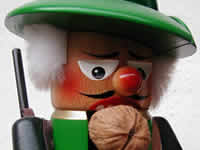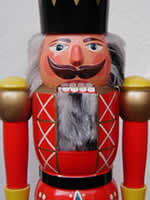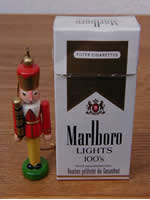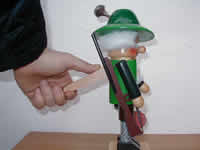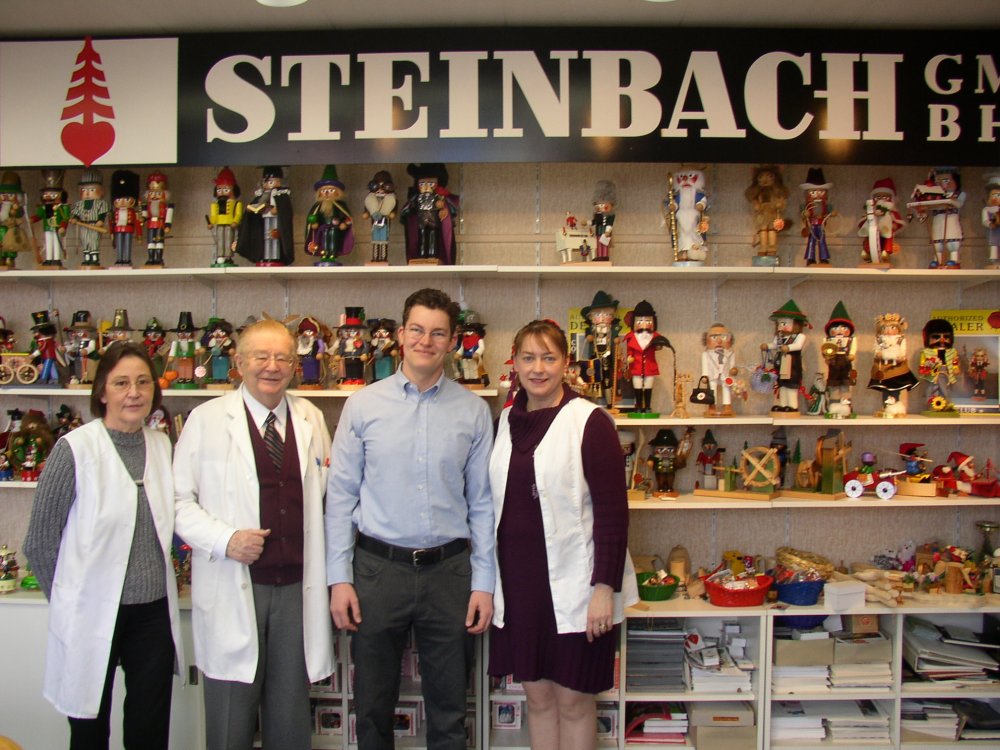|
Here we have gathered some more info on the two most important
nutcracker producers these days:
The Steinbach nutcracker company and the Ulbricht nutcracker
company
CHRISTIAN STEINBACH Company
We visteted the Steinbach family in March
2004 in their location in Hohenhammeln ( from left: Mrs. Mustach,
Mr.Steinbach, Mr. Fux, Mrs. Karla Steinbach )
The Christian Steinbach, GmbH is the leading producer of
collectible nutcrackers and smokers today. Products are created
with exacting attention to detail from the finest of European
woods. Highly skilled artisans, who have trained many years
in the fine art of woodcarving, painstakingly handcraft the
Steinbach nutcrackers, smokers, taranellas, ornaments and
much more.
Christian Steinbach is the current President and overseas
product development and the manufacturing process. His daughter
Karla Steinbach assists him with management and is very involved
with design and product supervision as well. The main factory
is in Hohenhameln - near Hannover - in the northernpart of
Germany, and was begun just after World War II. After the
reunification of Germany, Mr. Steinbach regained the families
Erzgebirge factory, and production is now carried on in both
factories.
Although Mr. Steinbach has celebrated his 80th birthday, he
attracts hundreds of collectors at his signing events all
over the world, and his autograph automatically increases
the value of a nutcracker or smoker. He is renowned for his
funny anecdotes and legendary stories, and always greets his
collectors with gladness!
THE HISTORY OF Steinbach Nutcrackers:
According to German folklore, steinbach nutcrackers were given
as keepsakes to bring good luck to your family and protect
your home. The legend says that a nutcracker represents power
and strength and serves like a guard for your family from
danger and evil spirits. A fierce protector, the nutcracker
bares its teeth to the evil spirits and serves as the traditional
messenger of good luck and good will.
"Don't be afraid, my beard is long, my head is large,
my look is grim but that matters not. I won't bite you. In
spite of my big mouth and grim appearance, I look with my
heart for your happiness."
oSteinbach Nutcrackers embody the 'Cycle of Life', As the
seed of a nut falls to the ground, it grows into a strong
tree, living over hundreds of years nourishing the woodcutters
and woodcrafters. The legends tell of a feast celebrated just
before harvesting the logs of the Elder trees, where nuts
and fruits were eaten as if to pass on the magic and mystery
of this eternal cycle . . . and so on to the collectors of
these exquisite wooden nutcrackers.
oSteinbach Nutcrackers reflect ancestral dining customs where
amusing or unusual nutcrackers were part of the social setting
adding a whimsical conversation piece as guests lingered over
the desert course which included sweetmeats such as pecans
and hazelnuts.
oWriters, composers and artists sang and danced the praises
of the legend of the Nutcracker beginning with the novel "The
Nutcracker and the King of Mice," written sometime between
1776 and 1822, by E.T. Amadeus Hoffman. This novel became
the basis for Tchaikovsky's magnificent "Nutcracker Suite",
which debuted as a ballet in St. Petersburg in 1892 and lives
on as a holiday tradition throughout the world.
"If you sit down under one of these trees you might hear
the rush and rustle of the tops, telling you about the German
legends and the history witnessed by these trees," says
Mr. Steinbach.
HOW STEINBACH NUTCRACKERS CAME TO AMERICA
Steinbach Nutcrackers have always been enjoyed for their whimsical
expressions. authentic costumes, and enigmatic charm. However,
nutcrackers also possess a rich history that goes back about
300 years. Steinbach Nutcrackers carry with them a sense of
tradition as well as an abundance of stories and legends of
the past. Although nutcrackers have been around forages, they
were not always the collectible items as we know them today.
In fact, nutcrackers only became popular in the United States
about 50 years ago.
The practice of collecting nutcrackers in the United States
began in the early 1950's. Many of the GI's who were in Germany
during World War II visited "Kristkindl Markt",
which were open air fairs or markets. It was there that they
discovered a sturdy and intriguing companion in the nutcracker.
When the soldiers returned home after the war, a new comrade
accompanied them. Strengthened by the nutcracker's ability
to ward off evil from its owners, the soldiers brought a figure
of power and protection to their families and loved ones.
And so, the nutcrackers with their rich heritage had arrived
in the United States, and were here to stay.
When Tchaikovsky's ballet, The Nutcracker Suite premiered
in St. Petersburg in 1892, the popularity of nutcrackers spurted
tremendously. The ballet became very popular in the United
States in the early 1950's and ignited the passion for these
fascinating creatures. The magic and mystery of the ballet
has intrigued and enchanted audiences year after year. The
strong following of this classic production greatly increased
the popularity of collecting nutcrackers in America.
The role of the Steinbach family in contributing to the rising
popularity of nutcrackers can not be overemphasized. The first
nutcrackers, created mainly in the Erzgebirge, depicted images
of kings, military officers, and other prominent members of
the upper classes. Herr Steinbach, in his own unique way,
altered this tradition and raised the nutcrackers to a different
level. The subjects of the nutcrackers were expanded to depict
characters from German folklore and legend. Introducing nutcrackers
representing characters from different areas of the globe
was another Steinbach innovation. Herr Steinbach's vast choice
of subjects and superb quality and craftsmanship helped strengthen
the perception of the nutcracker as a treasured collector's
piece.
The next step in Steinbach's quest for uniqueness came with
the development of the limited edition nutcracker. The first
limited edition nutcracker piece was King Ludwig II, which
was limited to 3000 pieces. The idea of a limited nutcracker
produced an overwhelming response because it contributed to
the collectability of the nutcrackers and greatly increased
their value.
When Herr Steinbach crossed the Atlantic, he visited many
collector shows and spoke to both existing collectors and
those who were interested in starting a collection. His animated
personality and sincere interest in each and every collector
created instant electricity between the two. His individual
treatment of each nutcracker collector combined with the superb
quality of the pieces, helped create a uniquely collectible
product which has survived the test of time. The concept took
hold and has expanded with collectors clubs, more limited
editions and you, the collector who appreciates the beauty,
quality and sense of exciting tradition that accompanies each
individual nutcracker.
The mettle of the family is evidenced in the quote: "If
one does not work hard to earn the heritage, one will perish
in the end or at best hold the stirrups for those who are
on their way up." That fortitude was rewarded over the
centuries.
"To produce one nutcracker," explains Herr Steinbach,
"can involve up to 130 separate procedures. At one time
the curing and natural drying to the wood could take up to
3-4 years depending upon the piece.
Ulbricht Company
Christian Ulbricht was born in Seiffen in 1933. His father,
Otto, was a wood turner who had a factory which made nutcrackers,
smokers and other wooden collectibles. After World War II,
private industry was taken out of the hands of the individual,
and controlled by the Communist regime. At that time, Otto
moved his family across the border to West Germany and settled
in Lauingen where he continued his nutcracker business
Mr. Ulbricht took over the family business in 1968, and in
1978 developed a new company named Holzkunst Christian Ulbricht.
After Germany was re-united, Mr. Ulbricht was able to purchase
the family factory in the Erzgebirge, which is now called
Seiffen Nussknackerhaus. Now Ulbricht products are produced
in both locations. While son Gunther remained in Lauingen,
daughter Enis moved to Seiffen to manage the factory there.
Christian himself will create samples on the lathe, and this
becomes the pattern for the workers who handcraft the finished
pieces. Gunther, an artist in his own right, has created many
of the new designs. And Ines and mother Inge are also involved
in the design of nutcrackers, smokers, music boxes, pyramids,
and ornaments that are produced in both factories.
Now well into the third generation, the Ulbricht family continues
to produce wood turned products of the highest quality. With
each piece, you can be assured you have a collectible made
in the traditions of excellence for which the Ulbricht family
is known in both locations.
As with the Steinbach nutcrackers , the Ulbricht nucracker
gain in value, the older they get, with the signature they
have and the lowest possible limited Edition number they have.
Happy collecting !
 to
the top to
the top |



